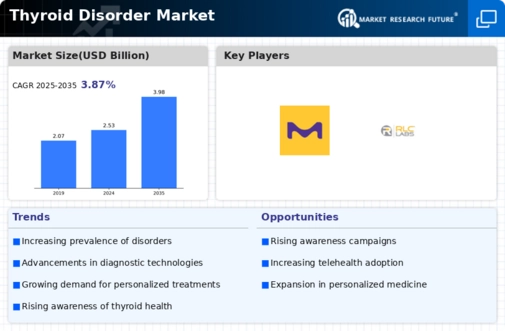Market Analysis
In-depth Analysis of Thyroid Disorder Market Industry Landscape
The market dynamics of the thyroid disorder market are shaped by various factors that influence supply, demand, pricing, and overall industry growth. Thyroid disorders, including hypothyroidism, hyperthyroidism, and thyroid nodules, affect millions of people worldwide and require various treatment options. Several key dynamics drive the performance of this market.
One of the primary drivers of the thyroid disorder market is the increasing prevalence of thyroid disorders globally. Factors such as iodine deficiency, autoimmune diseases, genetic predisposition, and environmental factors contribute to the rising incidence of thyroid disorders. As awareness about thyroid health grows and diagnostic techniques improve, more individuals are diagnosed with thyroid disorders, driving demand for diagnostic tests, medications, and treatment procedures.
Technological advancements play a significant role in driving market dynamics in the thyroid disorder market. Innovations in diagnostic imaging techniques, such as ultrasound, computed tomography (CT), and magnetic resonance imaging (MRI), enable healthcare providers to accurately assess thyroid nodules and evaluate thyroid function. Additionally, advancements in thyroid hormone replacement therapies, surgical techniques, and minimally invasive procedures offer more effective treatment options for patients with thyroid disorders, driving market growth.
Demographic trends also influence market dynamics in the thyroid disorder market. Aging populations worldwide are at a higher risk of developing thyroid disorders, particularly thyroid nodules and thyroid cancer. As the elderly population grows, there is a greater demand for thyroid diagnostic tests, medications, and treatment procedures. Additionally, changes in lifestyle factors, such as diet, exercise, and stress levels, contribute to the prevalence of thyroid disorders among younger age groups, driving demand for preventive healthcare and early detection measures.
Regulatory factors significantly impact market dynamics in the thyroid disorder market. Stringent regulations govern the approval, manufacturing, and marketing of medical devices, diagnostic tests, medications, and treatment procedures used for thyroid disorders. Compliance with regulations such as those set forth by the Food and Drug Administration (FDA) in the United States and the European Medicines Agency (EMA) in Europe is essential for companies operating in this market. Manufacturers must ensure that their products meet safety and efficacy standards to obtain regulatory approval for sale and distribution.
Economic factors also play a crucial role in shaping market dynamics in the thyroid disorder market. Healthcare expenditure, reimbursement policies, and patient affordability influence the adoption of diagnostic tests, medications, and treatment procedures for thyroid disorders. Economic downturns may lead to reduced healthcare spending, affecting the purchasing decisions of hospitals, clinics, and patients regarding thyroid disorder management. Conversely, economic growth and increased healthcare investment can stimulate market expansion as more resources are allocated to thyroid disorder diagnosis and treatment.
Competitive dynamics impact the thyroid disorder market landscape. The market is characterized by the presence of both established players and new entrants competing for market share. Competitive strategies such as product differentiation, pricing tactics, marketing campaigns, and strategic partnerships shape the competitive landscape and influence market dynamics. Established companies often leverage their brand reputation, research and development capabilities, and distribution networks to maintain a competitive edge, while new entrants may disrupt the market with innovative products or services.
Globalization and international trade considerations also affect market dynamics in the thyroid disorder market. Manufacturers may seek to expand their presence in new markets with growing healthcare infrastructure and demand for thyroid disorder management solutions. International trade agreements, tariffs, and trade barriers can impact market access and pricing strategies for thyroid disorder products and services operating across borders. Additionally, cultural differences, language barriers, and regulatory compliance requirements may pose challenges for companies seeking to enter new markets or expand their product offerings internationally.





Leave a Comment